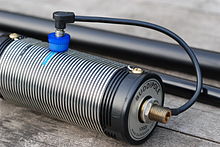Extension coil


An extension coil (also: antenna extension coil ; English loading coil ) is a coil for the electrical extension (and vice versa for mechanical shortening) of an antenna .
use
An extension coil is always connected in series with the antenna. An alternative, with the same goal of electrical extension of the antenna (or mechanical shortening), is the roof capacity .
Extension coils should have the lowest possible ohmic resistance and also generate the lowest possible inductive losses. They are therefore usually designed as air-core coils with thick turns.
Extension coils cannot always be placed on the base of the antenna, but must occasionally be installed in the center of the antenna. You can see this as a thickening in vertical antennas, for example. Even with self-radiating transmission masts and self-radiating transmission towers, it sometimes happens that extension coils are housed within the construction. One of these is housed in a cabin at the Blosenberg Tower in Beromünster at a height of 150 m.
A shortening capacitor at the base of the antennas has the opposite effect and leads to an electrical shortening of the antenna.
Pupin coil
Basically similar coils, called " Pupin coils " after their inventor Mihajlo Pupin (1854–1935), were used earlier - before the invention of low-noise electronic amplifiers - to equalize signals in long telegraph lines. In contrast to extension coils, Pupin coils are hardly of any technical importance today.
literature
- Eberhard Spindler: The great antenna book. 11th edition, Franzis-Verlag GmbH, Munich 1987, ISBN 3-7723-8761-6
- Gregor Häberle, Heinz Häberle, Thomas Kleiber: Expertise in radio, television and radio electronics. 3rd edition, Verlag Europa-Lehrmittel, Haan-Gruiten 1996, ISBN 3-8085-3263-7
Web links
- Overman-high extension coil of a historical long wave transmitter at 60 kHz for 200 kW from 1912
- Extension coil in the transmitter mast of the TWN radio beacon in Twenthe, Netherlands
Individual evidence
- ↑ Handbook for high frequency and electrical technology, Volume V, specialist dictionary, Verlag für Radio-Foto-Kinotechnik GmbH, Berlin 1957; P. 41.